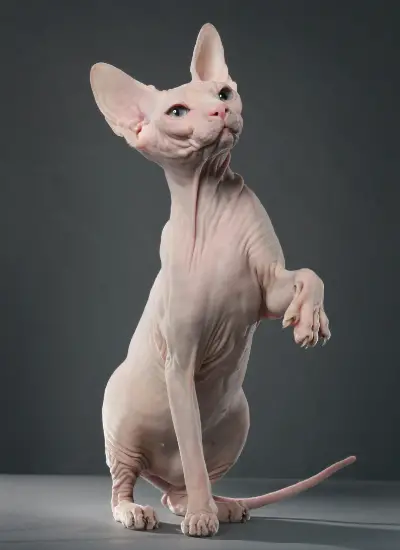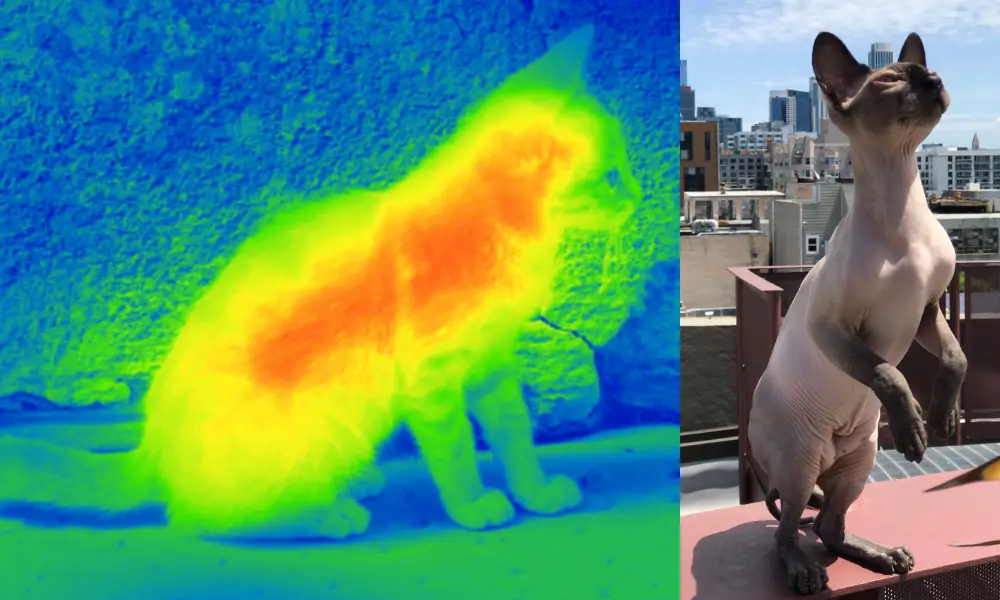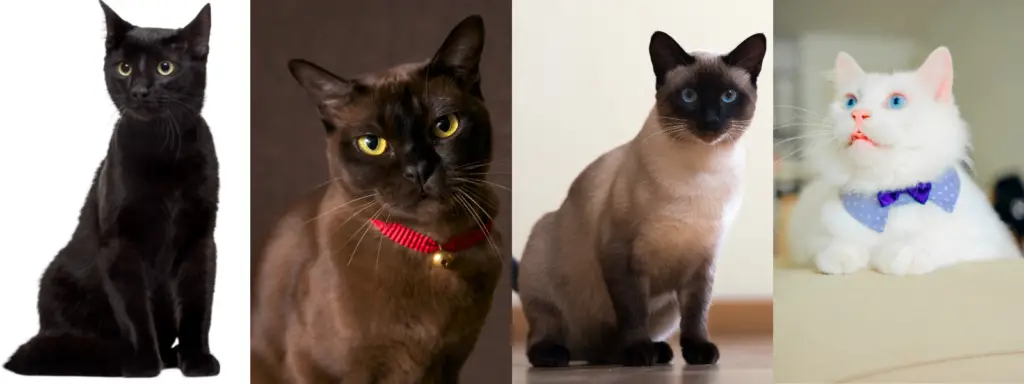
When thinking of an albino animal, the first thing that may come to mind is a snow-white, red-eyed rat or perhaps a white bunny with pink eyes. So what does albinism look like in sphynx cats, and do true albino sphynx even exist, or are they a myth?
Albinism in sphynx cats will present as pinkish-white skin with light blue eyes and no other skin markings. Albino cats can easily be confused with white cats. The only way to determine true albinism is by doing a genetic test for albinism. Albinism is extremely rare in cats, with less than 2% of cats being true albino.
In this article, we will unpack some basic coat coloring genetics related to white and albino cats and how you might be able to tell whether your sphynx is a true albino. You might also find it interesting to learn that the genes for albinism relate to the gorgeous color point sphynx genes.
What Causes Albinism In Sphynx Cats?
Simply put: albinism is caused by a natural genetic mutation causing reduced production of melanin (pigment) in different areas of the body, but most notably in the skin, hair, and eyes.
In albino cats, the TYR gene sequence coding for an enzyme called tyrosinase carries a mutation, resulting in little or no production of tyrosinase. Tyrosinase plays an integral part in melanin (pigment) production by melanocytes (pigment-producing cells). Therefore, if there is no tyrosinase, melanocytes cannot produce melanin.
Albinism is an autosomal recessive trait in cats meaning that a cat needs to inherit a genetic copy of the trait from both parents to be albino. Among the color genes coding for tyrosinase production, albinism is the most recessive. This explains why albinism is so rare, with less than 2% of cats expressing the mutation on the TYR gene resulting in albinism.
Temperature-Sensitive Color Genes Linked To Tyrosinase Production
Hundreds of different genes contribute to the color of a cat’s skin, fur, and eyes. The color a cat ends up being is determined by the most dominant gene in a particular cat. Not all of these genes are related to the TYR gene coding for tyrosine production, but it might be helpful to understand how the genes for tyrosine production relate to albinism.
As explained above, the enzyme tyrosinase plays an integral part in the production of melanin, and the amount of tyrosinase directly correlates with the amount of melanin produced. The absence of tyrosinase will result in albinism. Interestingly, some TYR gene sequences will result in temperature-sensitive tyrosinase production. This is seen in the thermal or color point coat variations.
Thermal or Color Point Coat Coloring
Among other coat colorings that are influenced by tyrosinase (only one of many genetic factors influencing coat color) is the temperature-sensitive coat colorings. Sphynx cats who have temperature-sensitive tyrosinase activity are also sometimes called thermals.
Thermal coat coloring results from genes causing tyrosinase to be inhibited by heat. The result is that the cooler parts of the cat’s body, such as the nose, ears, feet, and tail are darker than the warmer parts, such as the torso.
Among these temperature-sensitive genes that influence tyrosinase are the coat colorings for burmese and siamese. In burmese coat coloring, tyrosinase production is only partially inhibited by heat, while in siamese coat coloring, tyrosinase is entirely inhibited by higher skin temperature.

If we were to rank the dominance of the genes governing tyrosine production, it would be as follow:
C (full colour) > cb (burmese) cs (siamese) > c (albino).
A kitten will inherit two copies of each gene (one from each parent). In most cases, only the dominant copy of the gene will be expressed. Coat color genetics can become rather complicated, but the point I would like to make here is that based on the genes governing tyrosinase activity, albino is the most recessive gene, which means that a kitten will have to inherit a copy of the gene for albino coloring from each parent to be albino – which is exceptionally improbable and somewhat of a miracle in itself!

What Is The Difference Between A White Cat And An Albino Cat?
While white cats still produce the pigment melanin, they will produce less of it in their skin, resulting in a predominantly white coat color. Albino cats, on the other hand, make no or very little melanin due to a missing enzyme used in pigment production. In short: the genes for white coat color and albinism are entirely different.
The genes that code for a white or predominantly white coat color are an autosomal dominant trait found on different chromosomes than the recessive TYR-dependant albino gene sequence. The genetic sequences that cause predominantly white coat color are therefore unrelated to the genes that cause albinism.
White or pink sphynx cats will still be able to produce melanin, as the tyrosinase enzyme needed for melanin production is still produced normally in these cats. White cats have fewer melanocytes (pigment-producing cells) in their skin and, sometimes, their eyes and therefore carry similar risks for skin cancer as albino cats do.
If you cross paths with an all-white cat with blue or yellow eyes, it is more likely to be predominantly white coat color rather than albino. This is because the white coat coloring is a dominant trait and will therefore be preferentially expressed if a kitten inherits a copy of the predominant white trait along with the genes for a less dominant coat color trait.
Along with a similar risk for skin cancer, white cats with blue eyes are more likely to be deaf in one or both ears. I will touch on this again in the section on hearing problems.
How To Tell If A Sphynx Cat Is A True Albino
1. There Are Multiple Color Point Or Thermal Coat Patterns In The Kitten’s Pedigree
We now know that the genes that result in albinism relate to the genes for a color point or thermal coat colorings. If a light color point sphynx (siamese coloring) is bred to another light color point sphynx, and there happens to be a mutation on the TYR gene in the offspring, the offspring will carry one or two copies of the gene sequence for albinism.
A kitten that carries the TYR gene mutation in both alleles – one in the copy of each gene inherited from each of the kitten’s parents – will be albino. This is because albinism is a recessive trait, so for a kitten to be albino, it needs two copies of the genetic sequence for albinism.
This is by no means a hard and fast rule or means to say that a snow-white kitten born to color point parents will be albino, as there are many other genes that influence which coat color is expressed, but it will certainly be more likely that the kitten may be a true albino.
2. The Cat Has No Markings And Has Pale Yellow Or Light Blue Eyes
This point is quite apparent, as we know that albino animals produce little to no pigment; however, some albino cats may have slight markings or areas of melanin production. This is exceptionally rare, and an all-white cat with light-colored eyes is simply a means to increase our suspicion that a cat may be albino.
Nature does not always abide by the rules, and it is true that in sporadic cases, albino cats can have pale yellow eyes. This will be due to a small amount of melanin being produced in the iris.
3. The Eyes Have A Pink Tinge Or Appear Red In Some Instances
Albino cats do not have the red or pink eyes sometimes seen in albino rats or rabbits, but their eyes may have a pinkish tinge. This is because the absence or minimal amount of melanin in the iris (colored part of the eye) and retina (back of the eye) makes it so that the blood vessels in the eye become visible, resulting in a pinkish tinge.
In some instances, the reflection off the back of the eye may appear red rather than white, as seen in non-albino cats. For example, think of how a cat’s eyes may appear bright white in flash photography, and a human’s eyes will appear red. In flash photos, an albino cat may have a similar ‘red-eye’ phenomenon.
Non-albino cats (and most other animals) have a thick layer of pigment in the back of their eyes (tapetum lucidum) which will cause light to be reflected off the back of the eyes, and thus, the white reflection. On the other hand, humans and some albino cats have very little or no pigment in the back of their eyes, which causes the red from the blood vessels in the eye to be visible.

4. Genetic Test For Albinism
The only truly reliable and definite way to diagnose albinism is by a genetic test that can be done to check whether a cat has two copies of the gene sequence for albinism. This test is offered by the UC Davis Veterinary Genetics lab but is not part of the coat color panel due to its extreme rarity, but can be ordered as a separate test.
To see the current pricing and specifications of the test, you can check the UC Davis Veterinary Diagnostics Laboratory‘s website.
Will Albino Sphynx Cats Have Hearing And Vision Problems?
Hearing and vision problems are notably more prevalent among animals with little to no pigmentation in their skin and eyes (usually blue-eyed, white animals). This is because melanin plays an integral part in the normal development of these senses.
Deafness And Skin Color
The type of deafness associated with coat color is classified as congenital sensorineural, meaning that the deafness is caused by a genetically inherited trait and causes permanent loss of the ability of the nerves and inner ear structures to pick up and convey auditory stimuli.
Deafness is more closely associated with white, blue-eyed cats than with actual albino cats. However, due to the importance of melanin in the development of the inner ear, albino cats still have a higher likelihood of hearing impairments than heavily pigmented cats.
Congenital sensorineural deafness does not always affect both ears. In fact, it is more common for only one ear to be affected; however, this is vastly underdiagnosed as deafness in one ear usually goes unnoticed unless a specialized hearing test called a BEAR test is done.
Vision Problems In Albinos
Albino cats commonly have vision impairments. Again, this is due to the vital role melanin plays in the development of the optic nerve and the retina. In most cases, the lack of melanin will result in poor visual acuity and lack of depth perception, but in extreme cases, it may result in blindness.
Due to this fact, albino cats are often very clumsy and should therefore be kept as strictly indoor-only cats.
Is Breeding An Albino Sphynx Unethical?
Albinism is not directly harmful to a sphynx cat; however, ethical breeding aims to avoid breeding animals with genes that may cause the offspring to have hereditary health conditions. It is generally considered unethical to breed deaf and blind animals however breeding albino animals that are otherwise healthy and normal falls in a grey area.
It may be argued that albino sphynx cats will be prone to sunburn and subsequent skin cancer, along with having a higher likelihood of having hearing and visual impairments, and this may be enough reason to say that breeding an albino sphynx is unethical.
On the other hand, this will lead us to question whether breeding a sphynx is ethical in the first place. A sphynx cat will barely survive outside the confines of a comfortable home under the care of an attentive owner.
In the light of the animal improvement act (which most countries have), all breeders should avoid breeding animals with inferior genetics. However, still, we are swooned by striking exotic looks and captivating personalities. Before we know it, people are willing to shove heaps of money onto breeders who can provide them with a unique and exquisite pet worthy of their own Instagram account.
Sphynx cats have a lot going for them: charming personalities, brilliant intelligence, and striking looks. And under the care of a diligent and responsible owner, they can thrive and live long healthy lives; however, their hardiness pales in comparison to the vigor of the regular old domestic shorthair cat.
I wish these types of questions had more clear-cut, black-and-white answers. If they did, we might not have the genetic blunder pets such as double merle fluffy Frenchies (just the first example that popped into my head) that struggle to get by every day and, if lucky, will make it to the age of 6 after their owner had to take out a bank loan to afford their medical care.
Common Questions About Albinism In Cats
Do All Albino Cats Have Red or Pink Eyes?
In sporadic cases, albino cats will have red or pink eyes, but it is more common for albino cats to have very light blue, light green, or yellow eyes.
There are different types of albinism n which the pigment production of other body areas is affected. For example, the color of the iris is determined by the amount of pigment produced in the eye.
If the iris contains no pigment, the retina’s pink can be seen through the iris. More commonly, there will be a small amount of pigment in the iris, which will cause the eyes to be light blue, yellow, or green (ascending order of amount of pigment produced in the iris).
Will Albino Cats Get Skin Cancer?
Albino cats have a significantly higher risk of developing skin cancer. This is because pigment plays an integral part in protecting the skin from the potentially harmful effects of UV rays from the sun. A complete lack of pigment means that the skin cells are more easily harmed by these rays, which can lead to skin cancer.
Do Albino Cats Have Vision Problems?
Cats with albinism have vision problems, including light sensitivity, difficulty with depth perception, and nystagmus (abnormal eye movement). This is because the same genetic coding that causes albinism plays an integral part in developing the optic nerve (the eye’s main nerve).
Albino animals may also be more sensitive to light due to the lack of pigment in their irises and retinas. The lack of pigment also causes their eyes to appear light blue or sometimes pink. The pink and red in the eyes of albino animals are seen because the blood supply to the back of the eye is visible due to the lack of opacity that the pigment would have caused in the iris and retina in non-albino animals.
Do Albino Cats Have Hearing Problems?
Albino cats may have hearing problems; however, albinism is less commonly associated with deafness than the genes for white coat coloring (non-albino white coat). This is because melanin (pigment) plays an integral part in functioning the inner-ear structures responsible for hearing.
What Is The Difference Between Leucistic And Albino Cats?
Leucism is the term used to describe animals that have a primarily white coat or a coat coloring that is lighter than what is considered normal for that species or breed. Albino cats have a mutation at a specific gene (TYR-gene) that causes a lack of pigment production, while leucistic animals still produce melanin.
Leucistic animals still produce melanin, but there is an abnormality in the migration of melanocytes (pigment-producing cells) into the layers of skin. In contrast, albino animals will make very little or no melanin.
Conclusion
Albino sphynx cats are probably the unicorns of the cat world. They are exceptionally rare. The only way to definitely diagnose albinism is by doing a genetic test for the naturally occurring mutation on the TYR gene.
If you are lucky enough to be the owner of one of these feline unicorns, extra care should be taken to protect them from dangers (due to their lack of visual acuity) and sunlight (due to their risk of skin damage due to UV rays).
Resources
- CARDEN, S., BOISSY, R., SCHOETTKER, P. and GOOD, W., 1998. Albinism: modern molecular diagnosis. British Journal of Ophthalmology, [online] 82(2), pp.189-195. Availacat at: <https://bjo.bmj.com/content/82/2/189.short>.
- Conlee, J., Parks, T., Romero, C. and Creel, D., 1984. Auditory brainstem anomalies in albino cats: II. Neuronal atrophy in the superior olive. The Journal of Comparative Neurology, [online] 225(1), pp.141-148. Available at: <https://onlinelibrary.wiley.com/doi/abs/10.1002/cne.902250115>.
- CREEL, D., 1971. Visual System Anomaly associated with Albinalbinismhe Cat. Nature, [online] 231(5303), pp.465-466. Available at: <https://www.nature.com/articles/231465a0>.
- Creel, D., Conlee, J. and Parks, T., 1983. Auditory brainstem anomalies in albino cats. I. Evoked potential studies. Brain Research, [online] 260(1), pp.1-9. Available at: <https://www.sciencedirect.com/science/article/abs/pii/0006899383907588>.
- Creel, D., Hendrickson, A. and Leventhal, A., 1982. Retinal projections in tyrosicate-negative albino cats. The Journal of Neuroscience, [online] 2(7), pp.907-911. Available at: <https://www.jneurosci.org/content/2/7/907.short>.
- Guillery, R., 1986. Neural abnormalities of albinos. Trends in Neurosciences, [online] 9, pp.364-367. Available at: <https://www.sciencedirect.com/science/article/abs/pii/0166223686901153>.
- Imes, D., Geary, L., Grahn, R. and Lyons, L., 2006. Albinism in the domestic cat (Felis catus) is associated with a tyrosinase (TYR) mutation. Animal Genetics, [online] 37(2), pp.175-178. Available at: <https://onlinelibrary.wiley.com/doi/full/10.1111/j.1365-2052.2005.01409.x>.
- Leventhal, A., Vitek, D. and Creel, D., 1985. Abnormal Visual Pathways in Normally Pigmented Cats That Are Heterozygous for Albinism. Science, [online] 229(4720), pp.1395-1397. Available at: <https://www.science.org/doi/abs/10.1126/science.3929383>.
- Prieur, D. and Collier, L., 1984. Maltese dilution of domestic cats. Journal of Heredity, [online] 75(1), pp.41-44. Available at: <https://academic.oup.com/jhered/article-abstract/75/1/41/834952>.

